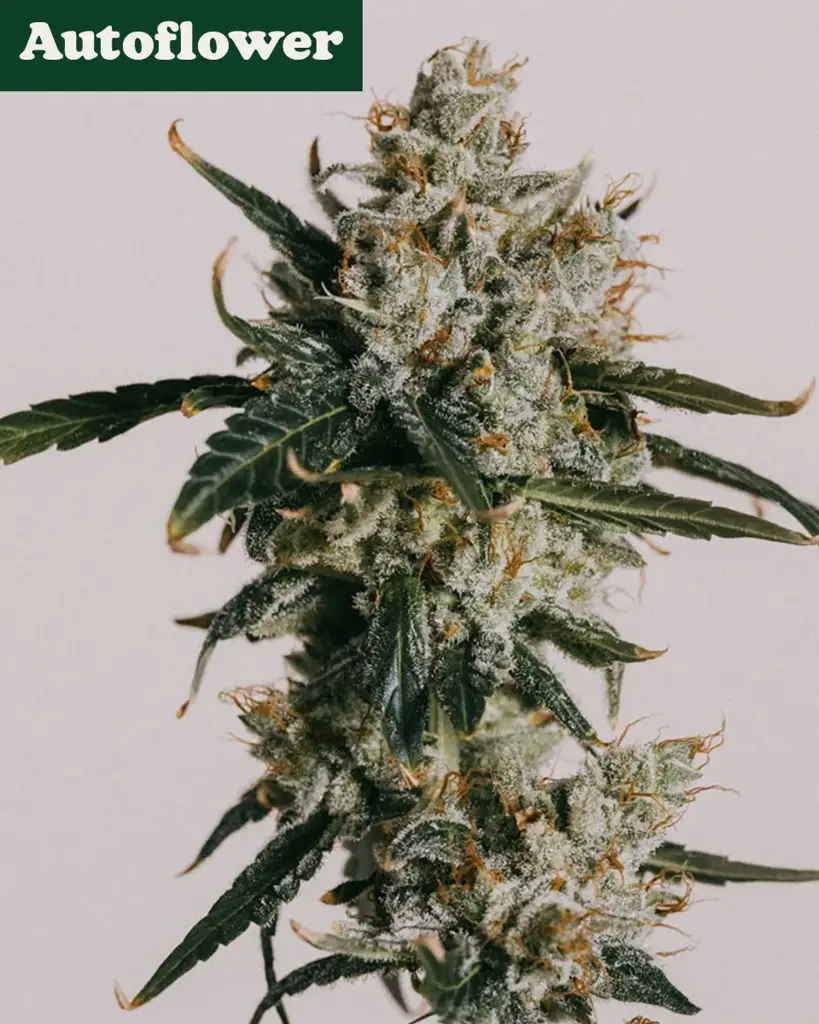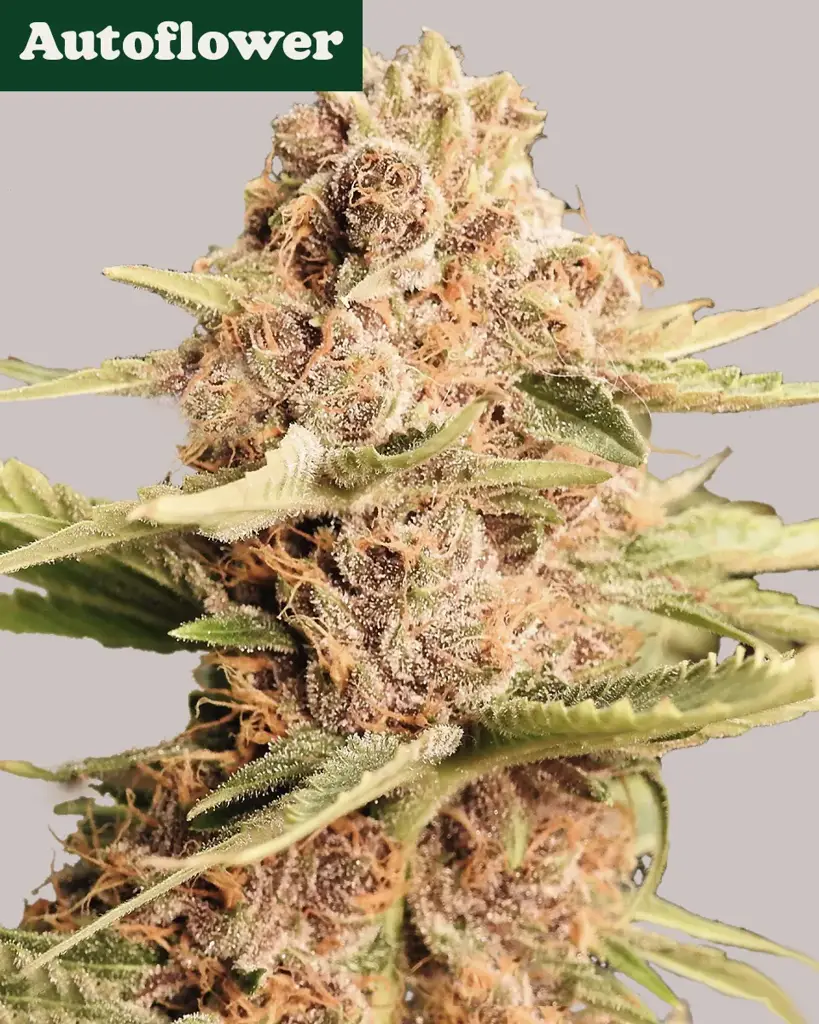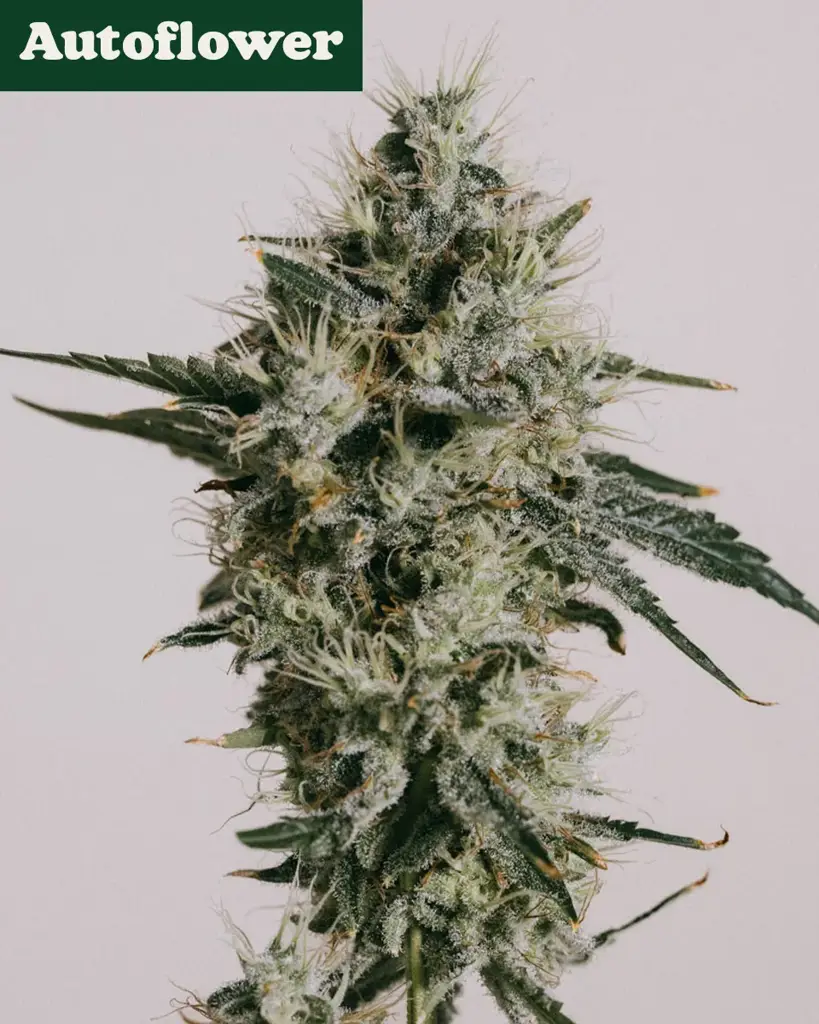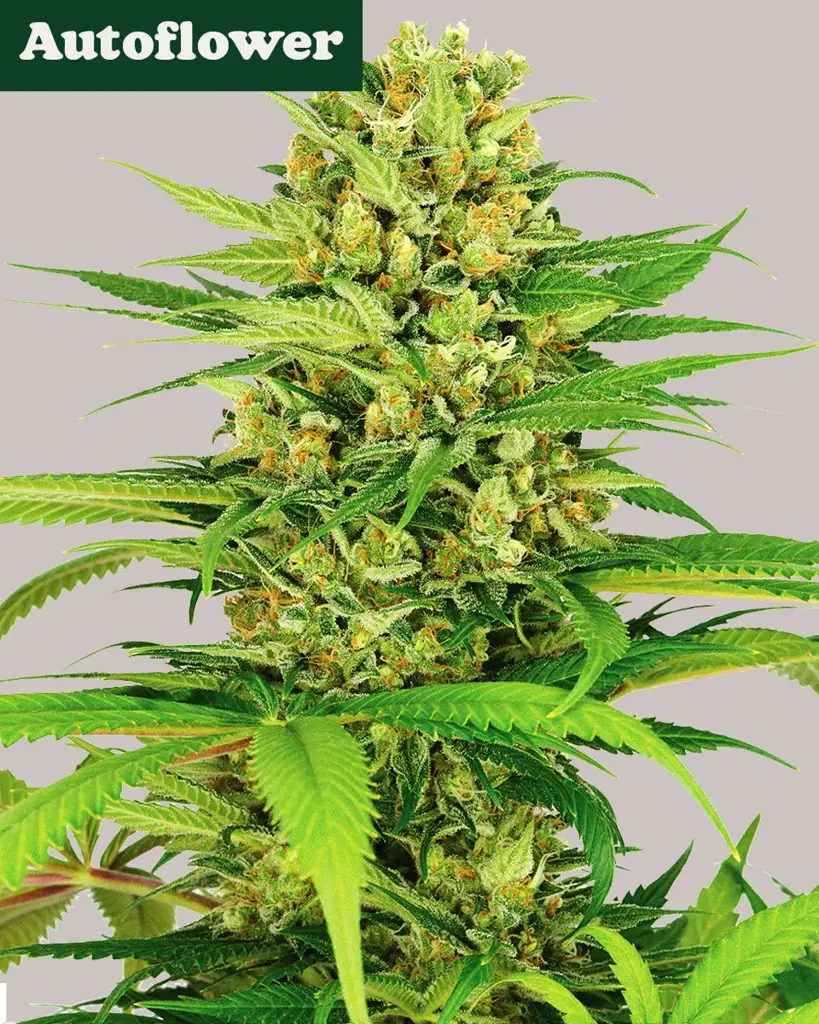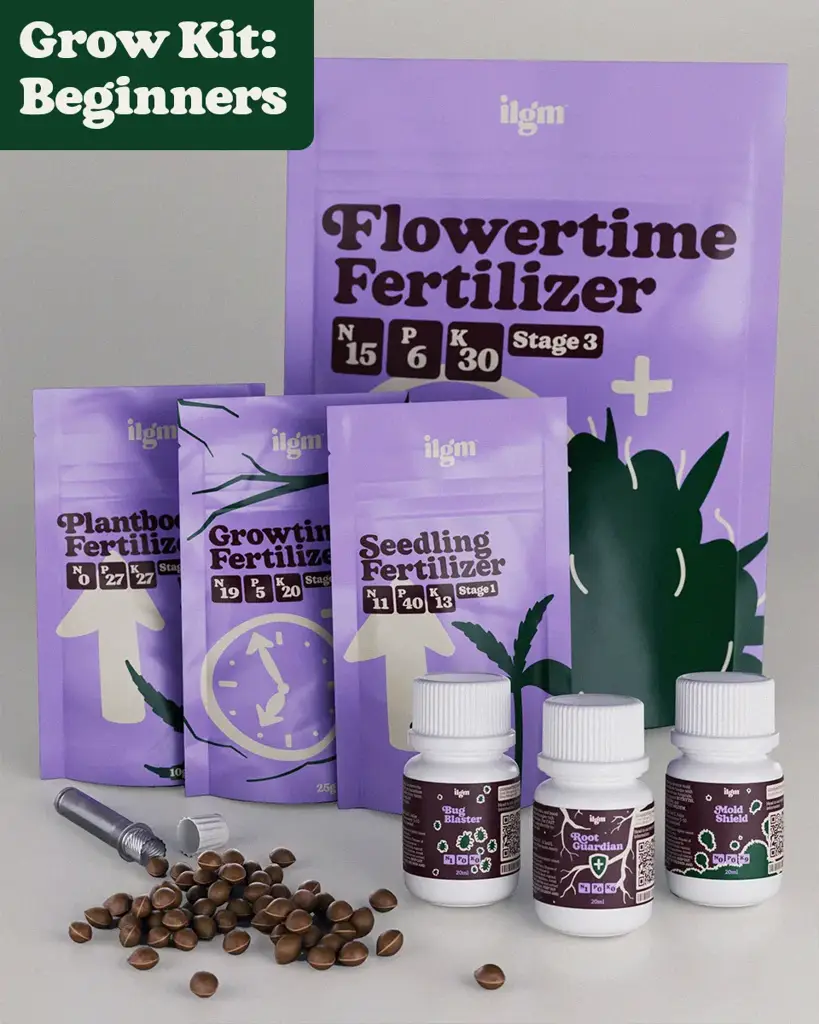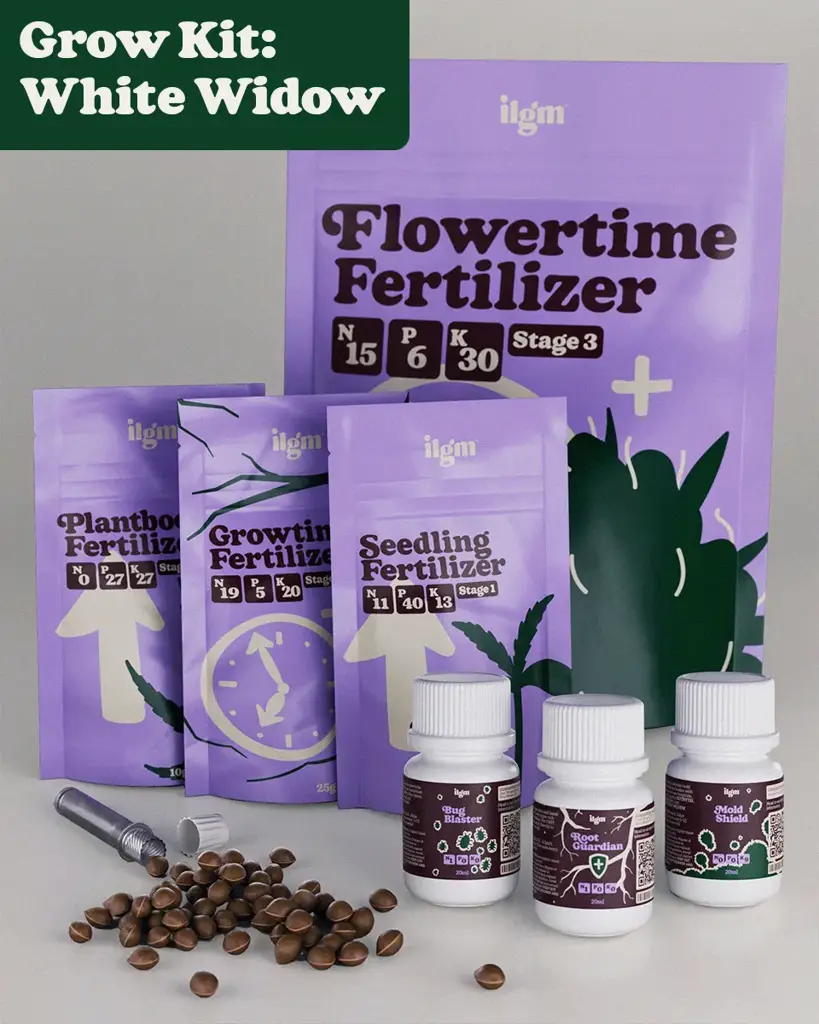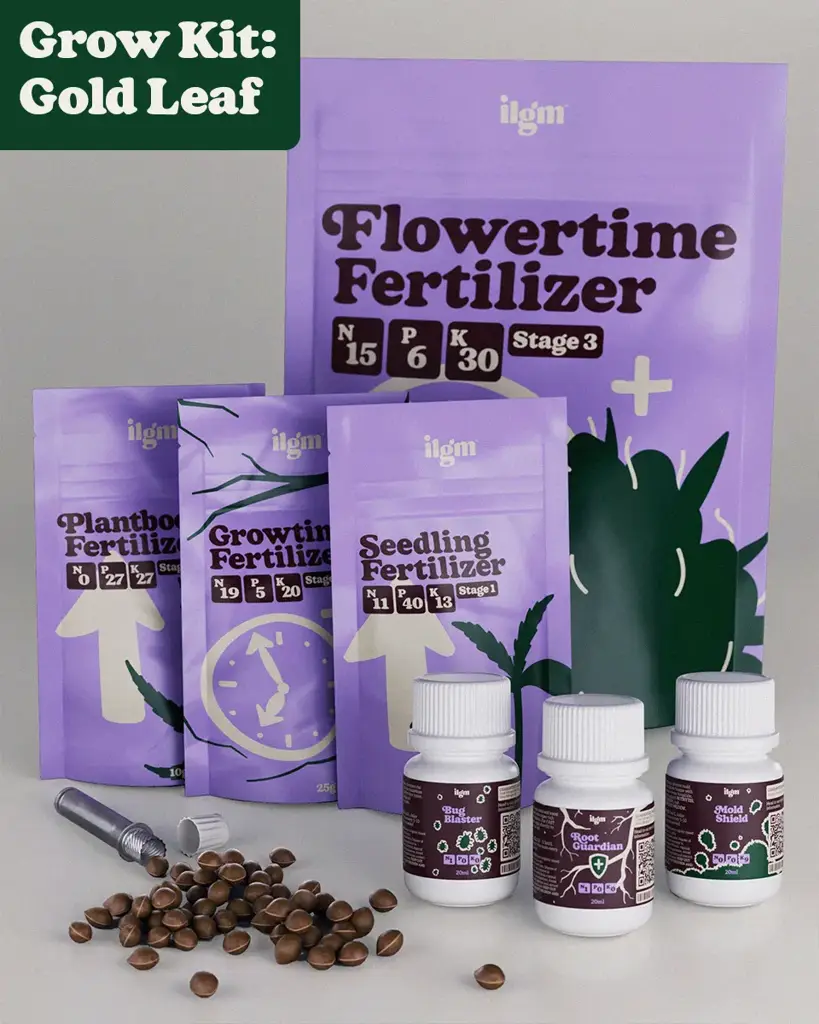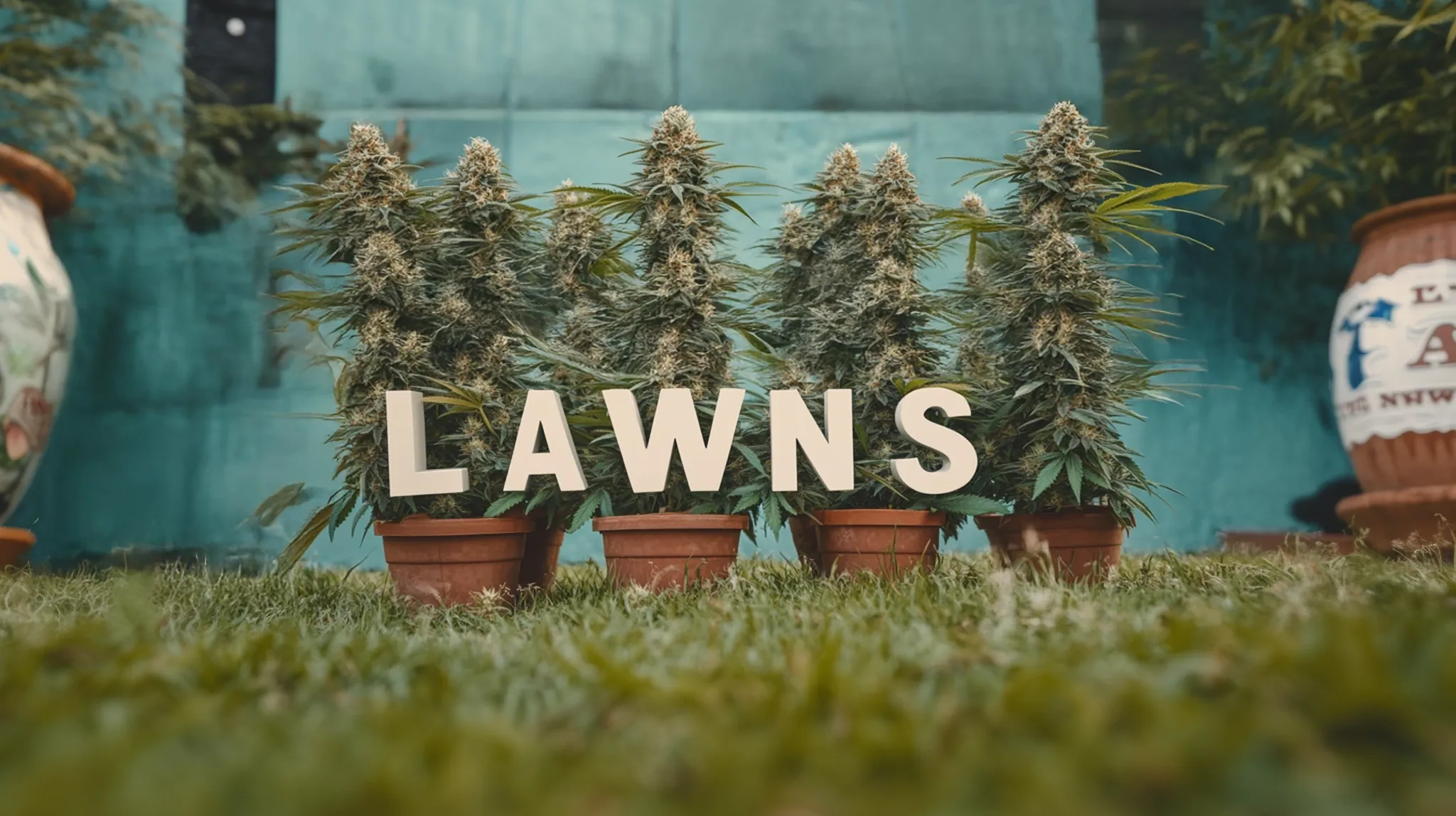
Supplies You Need to Start Growing Cannabis
Growing cannabis at home doesn't need to be a complicated process. It can be as simple or as sophisticated as you choose to make it. Some people are happy to grow a couple of plants out in the garden, while others opt for high-tech indoor grows. However, the basics of what your cannabis plants need are the same. In this guide, I'll walk you through everything you need to know about the supplies for both indoor and outdoor cannabis cultivation, helping you go from a curious beginner to a confident home grower.
Table of contents
Let's break it down into two sections: the necessities and the specific equipment you'll need to nurture those green beauties.
Our Bestsellers
The Basics: L.A.W.N.S
To grow cannabis, some elements are essential, and there's no getting around that—no matter if you're growing outdoors or indoors. I like to remember them using the acronym L.A.W.N.S, which stands for Light, Air, Water, Nutrients, and Soil/Substrate. These are the key elements your cannabis plants need to thrive.
Light
Cannabis loves light, as most plants do. They grow big and strong through photosynthesis by converting light into energy. Outdoors, the sun provides all the light your plants need, as long as you're in the right latitude (sorry for those living at the poles).
Indoors, the lighting now rests in your hands, and you’ll have to bring the “sun” to them in the form of artificial light, like with LED. More on that later when we cover grow lights.
Air
Fresh air is another must for healthy cannabis growth. Without proper air circulation, you could face issues like bud-rot, pests and mold, weak stems, and a whole slew of other troubles nobody got time for.
Outdoors, the breeze does the trick, but for indoor grows, you'll need multiple fans to keep the airflow moving.
Water
Like any living thing, cannabis needs water. It's the life force that runs through us all and without it, your plants don't stand a chance. The amount of water your cannabis plants receive depends on your setup, climate, and plant size. Consistent watering is key, especially indoors, where you’re in charge of everything.
Nutrients
Cannabis requires nutrients to grow properly. Nature is an abundant supplier, so outdoors, nutrients can come from compost and the natural environment. Indoors, you'll need to play the role of mother nature and provide a balanced diet through fertilizers.
Soil/Substrate
This is where your plants' roots grow and where they absorb water and nutrients. Outdoor growers can simply use the ground, while indoor growers often opt for a more controlled substrate like potting soil, coco coir, or rockwool.
Growing cannabis can be as basic as throwing some seeds in a field and hoping for the best, or it can be a bit more "hands-on," where you nurture each plant like a beloved pet. Heck, some people even sing to their plants, but that's a whole other topic on its own. Let’s move on and talk about how to get a bit more involved with specific cannabis-growing supplies.
Essential Cannabis Growing Supplies
Now that you know the basics, the next step is to get familiar with the tools and equipment you’ll need to grow dank weed—indoors or outdoors. This list covers everything from beginner-friendly essentials to optional add-ons that can help boost your yields or simplify the process.
1. Seeds or Clones
 Almost anyone could grow weed, but you’ve got to start somewhere, right? This leaves you with the option to either grow from seeds or clones.
Almost anyone could grow weed, but you’ve got to start somewhere, right? This leaves you with the option to either grow from seeds or clones.
Seeds: The benefit of starting from seed is that they give you unique plants (phenos) and can grow stronger, higher-yielding cannabis plants. They also give you more options in the form of autoflowering and feminized seeds, which can (and should) be sourced from a reputable seed bank. However, starting with seeds means you’ll need to germinate them.
Clones: Clones are cuttings from a mature "mother" plant. They are genetically identical to that mother plant. A copy, if you will. This gives you the benefit of predictability. However, they may carry pests or diseases that the mother plant had.
2. Grow Lights (Indoor Only)
Light is by far the most crucial aspect of indoor cannabis growing. Cannabis plants rely on light not only for energy but also to signal which stage of growth they should focus on. To thrive, your plants need the right amount of light and the correct spectrum at different stages of growth. Here's what you need to know about the various lighting options and their applications:
Vegetative Stage: During this vegetative phase, plants prefer a blue light spectrum (400–500 nm), which promotes healthy leaf and stem growth.
Flowering Stage: When it's time to bloom, cannabis plants need a red light spectrum (620–750 nm) to encourage bud production. Red wavelengths mimic the sun's natural light during late summer and early fall, helping plants focus their energy on creating dense, resinous flowers.

Common Light Options for Cannabis Growing
LEDs:
 These are energy-efficient, run cooler, and offer adjustable light spectrums. This makes them an excellent choice for beginners and advanced growers alike. Modern LED grow lights generally use a lot less power and also last longer than other types of lights.
These are energy-efficient, run cooler, and offer adjustable light spectrums. This makes them an excellent choice for beginners and advanced growers alike. Modern LED grow lights generally use a lot less power and also last longer than other types of lights.HIDs (High-Intensity Discharge Lights):
 These produce intense light and are often used by experienced growers. HIDs come in two types: Metal Halide (MH) for the vegetative stage and High-Pressure Sodium (HPS) for flowering. While effective, they generate significant heat and require proper ventilation.
These produce intense light and are often used by experienced growers. HIDs come in two types: Metal Halide (MH) for the vegetative stage and High-Pressure Sodium (HPS) for flowering. While effective, they generate significant heat and require proper ventilation.CFLs (Compact Fluorescent Lamps):

Budget-friendly and suitable for small grows, CFLs are best for beginners with limited space. While they lack the intensity of LEDs or HIDs, they can still support decent growth when placed close to plants. However, we don’t recommend CFLs if you’re looking for optimized yields or dank nugs. They just don’t have the power LED and HID lamps have.
3. Grow Medium
For your plants to thrive, they need a home for their roots that offers hydration, nutritional value, as well as oxygen and stability. Choosing the right grow medium is an essential step in cultivating healthy cannabis plants. Here’s a breakdown of the most common options to help you decide what’s best for your grow:
1. Soil: The Beginner-Friendly Classic
 Soil is the most traditional and beginner-friendly option for cannabis growers. People have been successfully using it since the dawn of time. It naturally mimics the plant's outdoor environment and often comes enriched with nutrients, making it forgiving for new growers who are still getting a better understanding of fertilization schedules.
Soil is the most traditional and beginner-friendly option for cannabis growers. People have been successfully using it since the dawn of time. It naturally mimics the plant's outdoor environment and often comes enriched with nutrients, making it forgiving for new growers who are still getting a better understanding of fertilization schedules.
Pros:
Easy to work with and widely available. Our earth is covered in the stuff.
Organic soils, especially those enriched with compost or worm castings, provide a steady supply of nutrients, reducing the need for frequent fertilization.
Great for maintaining a natural, earthy growing style.
Cons:
Can be less precise in nutrient control compared to soilless mixes, like coco or peat moss.
Poor-quality soils may harbor pests or pathogens, so investing in a high-quality mix is important.
Tip for Beginners: Look for cannabis-specific potting soil or organic mixes labeled as "light" or "well-draining." It's best to avoid heavy garden soil that compacts easily.
2. Soilless Mixes: Maximum Control for Growth
Soilless mixes, like coco coir, perlite, or peat moss, are popular among growers seeking precise control over nutrients and water. These mediums provide excellent drainage and aeration. However, they require you to take a more active role in feeding your plants, as they don't contain nutrients naturally.
Coco Coir:
 Made from coconut husks, coco coir is lightweight, retains water well, and offers excellent root aeration.Often paired with perlite to improve drainage.Requires frequent fertilization with a nutrient solution since it contains no inherent nutrients.
Made from coconut husks, coco coir is lightweight, retains water well, and offers excellent root aeration.Often paired with perlite to improve drainage.Requires frequent fertilization with a nutrient solution since it contains no inherent nutrients.Perlite:
 A volcanic mineral that’s super lightweight and improves drainage and aeration.Typically used as a supplement to soil or coco coir rather than on its own.
A volcanic mineral that’s super lightweight and improves drainage and aeration.Typically used as a supplement to soil or coco coir rather than on its own.Peat Moss:
 Provides a spongy texture that retains water and nutrients well.Often mixed with perlite for aeration.Not sustainable as it’s harvested from peat bogs, so some growers prefer coco coir as an alternative.
Provides a spongy texture that retains water and nutrients well.Often mixed with perlite for aeration.Not sustainable as it’s harvested from peat bogs, so some growers prefer coco coir as an alternative.
Pros:
Allows for precise control of nutrients and pH.
Lightweight and easy to handle.
Reduced risk of overwatering due to excellent drainage.
Cons:
Requires more work and knowledge since you’ll need to provide all nutrients (in the correct ratios) manually.
Can be less forgiving for beginners if feeding schedules aren’t followed carefully.
4. Containers
So you've got your seeds, got your soil, and you're ready to get growing, but you are still trying to find out what pot is best to grow your pot in. For indoor grows, fabric pots or air pots are ideal since they improve root health by allowing better airflow:
Fabric Pots: Boosting Root Health with Airflow
 Fabric pots are made from breathable materials that allow air to penetrate the container’s walls. This increased airflow helps roots "air prune," a natural process where the roots stop growing once exposed to air, encouraging the development of smaller, lateral roots. These smaller roots improve nutrient and water absorption, leading to healthier, more robust plants.
Fabric pots are made from breathable materials that allow air to penetrate the container’s walls. This increased airflow helps roots "air prune," a natural process where the roots stop growing once exposed to air, encouraging the development of smaller, lateral roots. These smaller roots improve nutrient and water absorption, leading to healthier, more robust plants.
Benefits:
Improved Root Oxygenation: The breathable fabric ensures roots receive a constant supply of oxygen, reducing the risk of root rot.
Prevents Root Circling: Air pruning eliminates root binding, which occurs when roots spiral around the pot in plastic containers.
Reusable and Durable: High-quality fabric pots can be reused for multiple grows after proper cleaning.
Portable: Fabric pots are lightweight and easy to move, even when filled with soil or soilless mix.
Considerations:
Fabric pots dry out more quickly than traditional plastic pots, requiring more frequent watering.
They may leak excess water, so it's essential to use a tray or saucer underneath.
Air Pots: Engineered for Optimal Root Growth
 Air pots feature a unique design with perforated sides and raised edges, promoting excellent drainage and airflow. Like fabric pots, air pots encourage air pruning, which stimulates the development of a dense root system.
Air pots feature a unique design with perforated sides and raised edges, promoting excellent drainage and airflow. Like fabric pots, air pots encourage air pruning, which stimulates the development of a dense root system.
Benefits:
Enhanced Root Structure: The perforations prevent root circling, encouraging a healthier root network.
Excellent Drainage: Excess water escapes easily, preventing soggy roots and overwatering.
Reusable and Long-Lasting: Made from durable plastic, air pots can be used for several grows.
Considerations:
They can be more expensive than standard pots.
The assembly process may be slightly more complex for first-time users.
Other Container Options
While fabric and air pots are the most popular choices for indoor cannabis growing, other containers may suit your specific needs.
Plastic Pots:
 Affordable and widely available.
Affordable and widely available.
Retain moisture well but are prone to root circling and poor oxygenation unless modified with extra drainage holes.
Buckets:

A cost-effective option for larger plants.
Require drilling holes for proper drainage and airflow.
Self-Watering Pots:
Include a built-in reservoir that supplies water to the grow medium as needed.
Ideal for growers who may not be able to water frequently.
Tips for Choosing the Right Container
Size Matters: Choose a pot size appropriate for your plant’s growth stage. Seedlings and young plants thrive in smaller containers (1-3 gallons), while larger plants need more room (5-7 gallons or more for mature cannabis).
Drainage Is Key: Ensure your container has ample drainage to prevent overwatering and root rot.
Indoor Considerations: For indoor grows, prioritize pots that support airflow and fit well in your grow space.
5. Nutrients and Fertilizers
Cannabis plants need a balanced diet of macronutrients—Nitrogen (N), Phosphorus (P), and Potassium (K)—and essential micronutrients like Calcium, Magnesium, and Sulfur. Providing these nutrients in the right proportions at each stage of growth is critical for healthy plants and high yields. This is one of the more technical aspects of growing cannabis, and it can be the make-or-break of your crops, so it's worth learning.
Fertilizer Types
Organic Fertilizers: Derived from natural sources like compost, bone meal, or worm castings.
Pros: Eco-friendly, improve soil health, and promote a natural growing process.
Cons: Require time to break down and become available to plants.
Synthetic Fertilizers: Lab-formulated nutrients designed for immediate uptake.
Pros: Precise, fast-acting, and convenient for controlled feeding.
Cons: Risk of overfeeding if schedules and ratios are not carefully managed.
Synganic Fertilizers: A hybrid approach combining organic and synthetic fertilizers.
Pros: Offers the benefits of both systems—enhanced soil health from organic matter and quick nutrient availability from synthetic components.
Cons: Requires careful balance to avoid overloading nutrients or harming beneficial soil microbes.
Following Feeding Schedules for Every Growth Phase
Cannabis plants have distinct nutritional needs at each stage of growth. Following a phase-specific feeding schedule ensures they get the right nutrients when they need them:
Seedling Stage: Minimal feeding, as seedlings rely on energy stored in the seed. If using soil, ensure it’s light and nutrient-balanced.
Vegetative Stage: Increase nitrogen levels to promote leafy growth and strong stems. Keep phosphorus and potassium moderate.
Flowering Stage: Gradually reduce nitrogen while increasing phosphorus and potassium to support bud production and resin development.
Late Flowering/Flush: Use minimal nutrients or plain water to flush excess salts, improving the taste and quality of your harvest.
Tip: Monitor your plants for signs of nutrient deficiency or excess and adjust feeding schedules accordingly. For more detailed guides, check out our resources tailored to each growth phase.
6. Ventilation (Indoor Only)
 Clip on Fan as pictured above is perfect for ventilation in an indoor grow environment.
Clip on Fan as pictured above is perfect for ventilation in an indoor grow environment.
Proper ventilation is critical for indoor growing to prevent mold and encourage strong, healthy plants. This involves:
Oscillating Fans: To keep air moving around your plants.
Inline Fans and Exhaust Systems: To bring fresh air in and pull stale air out.
7. Heaters and Coolers
Maintaining the right temperature is crucial, especially indoors. Depending on your local climate, you might need a heater to keep your plants warm or a cooler to prevent overheating.
8. Humidity Control
Humidifiers and dehumidifiers are used to regulate the humidity levels in your grow area. Young cannabis plants love higher humidity while flowering plants prefer it a bit drier.
9. Thermometer and Hygrometer
You’ll need a thermometer to monitor temperature and a hygrometer to keep track of humidity. Cannabis plants are sensitive to their environment, so maintaining ideal conditions is key.
10. Watering Tools
 A good watering can, or a simple irrigation system helps ensure your plants get the right amount of water. For indoor grows, it's worth investing in a reliable pH meter to test your water’s pH, as cannabis prefers slightly acidic conditions (around 6-7 pH when growing in soil | 5.5-6.5 pH for hydroponics).
A good watering can, or a simple irrigation system helps ensure your plants get the right amount of water. For indoor grows, it's worth investing in a reliable pH meter to test your water’s pH, as cannabis prefers slightly acidic conditions (around 6-7 pH when growing in soil | 5.5-6.5 pH for hydroponics).
11. Pruning Tools
Sharp pruning shears are used to trim away unnecessary leaves and branches, helping your plant focus its energy on bud production.
12. Carbon Filter (Indoor Only)
 If you're growing indoors, a carbon filter attached to your ventilation system helps to neutralize the smell of cannabis, which can be pretty strong during flowering.
If you're growing indoors, a carbon filter attached to your ventilation system helps to neutralize the smell of cannabis, which can be pretty strong during flowering.
13. Extraction System (Indoor Only)
An extraction system is essential for getting rid of the hot, stale air in your grow space. It helps maintain a healthy environment by constantly replacing the air.
14. Grow Tent (Indoor Only)
A grow tent is a controlled environment where you can cultivate your cannabis plants. They are ideal for indoor growers who want to keep light, humidity, and temperature levels consistent. Grow tents also help keep pests out, and they come in various sizes to best suit your needs.
15. PPM Testing Tools
PPM (Parts Per Million) meters are used to measure the concentration of nutrients in your water or growing medium. This helps you ensure that your plants are getting the right amount of nutrients without overloading them.
First Grow?
Accessories for Better Results
Now that you have all the basics covered, there are a few optional supplies that can help improve your grow or make your life a bit easier.
1. Trays and Saucers
These help catch runoff water from your pots, keeping your grow space cleaner and safer.
2. Training Tools
For those looking to boost yields, training tools like plant ties, SCROG nets, or trellises can help you control plant shape and maximize light exposure to bud sites.
3. EC Meters
While not strictly necessary, we highly (pun intended) recommend you get an EC (Electrical Conductivity) meter that can help you keep track of nutrient uptake.
Conclusion
Growing cannabis, whether indoors or outdoors, requires care, attention to detail, and the right supplies. If you're a beginner who's just starting out (and you live somewhere suitable that's not too cold), you could go for a simple outdoor cannabis grow: all you need is Light, Air, Water, Nutrients, and Soil/Substrate (remember L.A.W.N.S?).
If you're planning to grow indoors, you’re going to need additional gear like grow lights, fans, and humidity control tools to mimic the ideal outdoor conditions. The initial cost and work may be higher for indoor operations, but don't forget - the more effort you put into providing the perfect environment, the better your yields and end quality will be.
Remember, growing weed can be as simple or as intricate as you make it. With the right weed-growing supplies, you'll be well on your way to growing healthy, happy cannabis plants—indoors or outside. Just take it step-by-step, and don't forget to enjoy the process.
After all, growing your own weed is one of the most rewarding experiences for any cannabis enthusiast.
See you later, cultivator.

Roach
Roach, a 20+ year cannabis enthusiast, activist & storyteller, blends humor, art & expertise—crafting words, strains & macabre masterpieces.
Continue Reading
You might also find these interesting.


